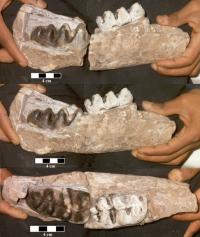
The teeth of the newly described Eritreum melakeghebrekristosi are a tip-off to its position as a missing link in the elephant family tree. Courtesty of U-M News Service A pig-sized, tusked creature that roamed the earth some 27 million years ago represents a missing link between the oldest known relatives of elephants and the more recent group from which modern elephants descended, an international team that includes University of Michigan paleontologist William J. Sanders has found.
The group's findings, to be published this week in the Proceedings of the National Academy of Sciences, suggest that mastodons and the ancestors of elephants originated in Africa, in contrast to mammals such as rhinos, giraffes and antelopes, which had their origins in Europe and Asia and migrated into Africa. The dating of the new fossil, discovered in the East African country of Eritrea, also pushes the origins of elephants and mastodons five million years farther into the past than previous records, Sanders said.
From 35 to 25 million years ago, representatives of the group known as proboscideans (which includes elephants, mastodons and their close relatives) lived only in Africa and Arabia, and most of them were palaeomastodonts. These animals were shorter and smaller than today's elephants, with short trunks and tusks and simple teeth that were all in place at the same time, as human adult teeth are.
After 25 million years ago, larger proboscideans such as mastodons and gomphotheres---the ancestors of modern elephants---dominated the scene. Elephant-sized, with long tusks and trunks, these advanced proboscidans had more complex teeth that emerged more slowly, so that each quadrant of the mouth had only one or two functional teeth in place at a time.
"The new fossil from Eritrea is important because it shows aspects of dental anatomy in common with the advanced group, including molars with more cusps and complex crowns and the delayed maturation and emergence of molars," said Sanders, an assistant research scientist in the U-M Museum of Paleontology. But the creature that the new fossil represents also had characteristics in common with palaeomastodonts, namely smaller body size and a jaw structure that suggests shorter tusks and trunk.
"In age and anatomy it is exactly the sort of intermediate evolutionists would expect to bridge the gap between archaic and advanced proboscideans," Sanders said.
Source : University of Michigan
 Print Article
Print Article Mail to a Friend
Mail to a Friend
